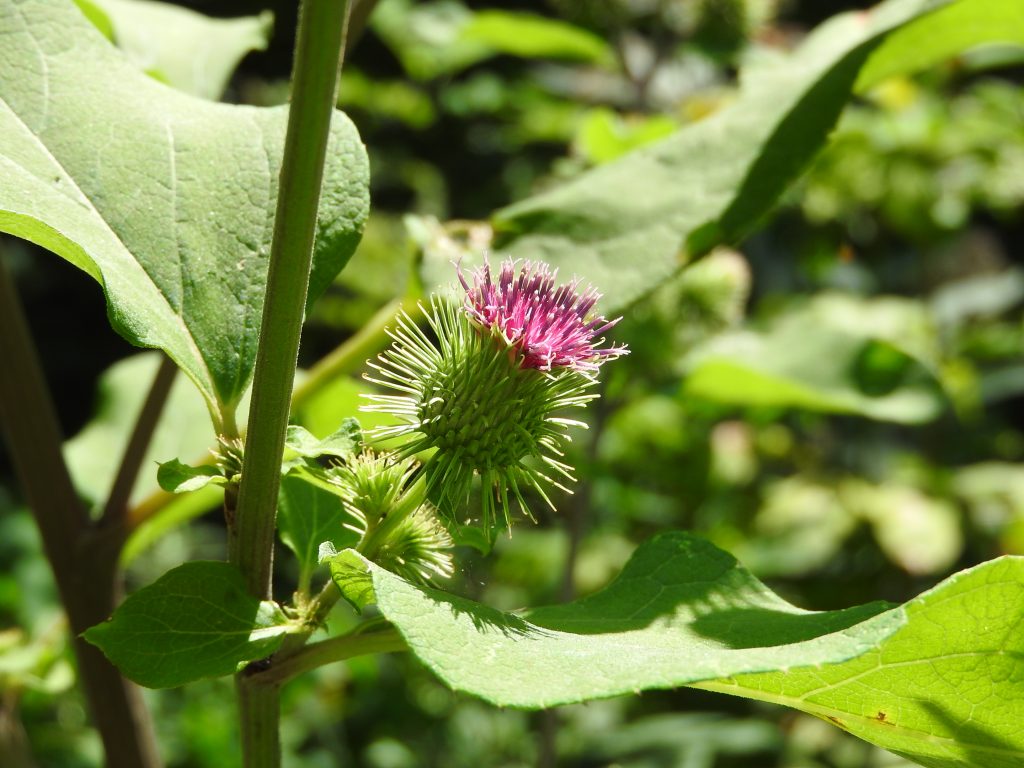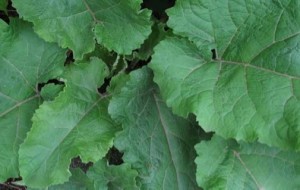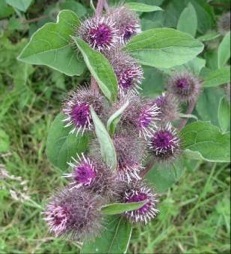
Burdock has a clingy nature. It is particularly bad in animal fur.
Arctium minus: Burdock’s Plus Side
I have a confession to make: When I was a kid I had a miniature corn cob pipe. And in it I smoked dried burdock leaf… I think that’s why my voice changed when I was seven.
We conspiratorial kids didn’t call it burdock. It was “snake rhubarb” and it did resemble the rhubarb in the garden… somewhat. My mother found out one day but decided the smoking was punishment enough. It was harsh, hot, dry and a lot of fun until she knew. Only years later would I return to the plant, this time to eat it and grow it.
Burdock is not native to North America. I grow Gobo, which is the original Japanese cultivated version of the plant. I had eaten it many times when I lived in Japan so it was an addition to my garden. Like many temperate plants it doesn’t like the Florida heat. (Horseradish, Lilacs, and Asparagus, for example, completely refuse to grow here.) What most people don’t know is burdock is an escaped plant from Asia. That was rather surprising to me because it was an extremely common weed in southern Maine, which is just about as far from Japan as one can get (I know because I was stationed in Japan while in the military.)
Burdock’s can make two claims to fame: It was in the original recipe for root beer, and, was the inspiration for velcro. Burdock is also the second half of the British drink Dandelion and Burdock. That concoction is even more bitter than Moxie, which is flavored with gentian root. And therein lies the burdock tale of woe: It is on the bitter side. That is how it protects itself from predators, by putting a layer of bitterness on the outside of the plant.
First year roots are the prime fare, young leaves can be eaten but you have to like bitter foods. As the roots age they become more bitter and woody, particularly in their second year. Peeled burdock stems are also edible, and not as bitter as the leaves. One of the reason why I like burdock, especially in temperate climates, is it’s a leaf large enough to wrap wild food in for cooking in the campfire. Wrap up a trout with some wild garlic and Northern Bay leaves and roast in the embers: Life is good. (See recipes on bottom of page.)
Burdock is in the same family with daisies, chicory, thistles and dandelions. There are at least three species of burdock in North America, all edible and all imports. The most common is the “lesser” Arctium minus. (ARK-ti-um MYE-nus) It grows from knee to shoulder height and is found just about everywhere except Florida. The “great burdock” and the “wooly burdock” are less known. The “great” can grow to nine feet high but usually doesn’t but its flowers are larger than the minus. The “woolly” has “fleece” on its flower heads.
The species name Arctium is Latinized Greek. The Greek is “arktos” meaning bear, in reference to the round, brown burs. Minus means the lesser or smaller since the Great Burdock (A. lappa) is larger. A. Lappa (LAH-pah) is a combination of Latin and Greek and means bur and to seize. A. tomentosum (toe-men-TOE-sum ) is the wooly burdock. Tormetosum means fuzzy or hairy.
Green Deane’s “Itemized” Plant Profile
IDENTIFICATION: Biannual. First year plant a low circle of rhubarb looking leaves with a foul odor. Second year flowering stalk, bushy, many purple flowers, thistle-like burs. Leaves usually large, ovate, woolly underneath, leafstalks usually hollow.
TIME OF YEAR: Middle summer to late fall, even after a frost, just mark where they are.
ENVIRONMENT: Sun or part shade, any type of well-drained soil. Grows a huge tap root so loosened soil is helpful to harvesting. Normally found along roadsides, barnyards, fence lines, disturbed soil, under bird feeders.
METHOD OF PREPARATION: First year roots can be eaten raw, or can be slow roasted for many hours making them sweeter. Older first year roots — scrubbed –boiled 20 minutes. Young shoots boiled until tender, more if bitter. Second year, stems peeled before flowering and boiled 20 minutes. Seed sprouts edible. Young leaves boiled edible but bitter. Leaf stems peeled and boiled. Also leaves can be wilted by fire then used for wrapping food.
HERB BLURB
Burdock has anti-bacterial and anti-fungal proprieties. It’s anti-cancer properties similar to broccoli and cabbage. Burdock is also a diuretic and the roots can be laxative.
Dandelion and burdock beer ingredients:
1 lb Young nettles
4 oz. Dandelion leaves
4 oz. Burdock root, fresh, sliced
-OR-
2 oz. Dried burdock root, sliced
1/2 oz. Ginger root, bruised
2 each Lemons
1 g water
1 lb +4 t. soft brown sugar
1 oz. Cream of tartar
Brewing yeast ( see the manufacturer’s instructions for amount)
Dandelion and burdock beer preparation:
1. Put the nettles, dandelion leaves, burdock, ginger and thinly pared rinds of the lemons into a large pan. Add the water.
2. Bring to a boil and simmer for 30 mins.
3. Put the lemon juice from the lemons,1 lb. sugar and cream of tartar into a large container and pour in the liquid thru a strainer, pressing down well on the nettles and other ingredients.
4. Stir to dissolve the sugar.
5. Cool to room temperature.
6. Sprinkle in the yeast.
7. Cover the beer and leave it to ferment in a warm place for 3 days.
8. Pour off the beer and bottle it, adding t. sugar per pint.
- 9.Leave the bottles undisturbed until the beer is clear-about 1 week.
Nettle, Dandelion and Burdock Beer
Ingredients: 450g young nettles
120g dandelion leaves
120g fresh, sliced or 60g dried burdock root
15g root ginger, bruised
2 lemons
4.5 litres water
450g plus 4tsp. demerara sugar
30g cream of tartar
Brewer’s yeast (see manufacturer’s instructions for amount to use)
Put the herbs and the thinly pared rinds of the lemons into a large pan with the water. Bring to the boil and simmer for 30 minutes. Put the lemon juice, 450g of sugar and the cream of tartar into a large container and add the strained liquid from the pan, squeezing the herbs well. Stir to dissolve the sugar and cool to blood heat. Sprinkle in the yeast. Cover the beer and leave to ferment in a warm place for three days. Rack off the beer and bottle it, adding half a teaspoon of sugar per pint. Leave the bottles until the beer is clear – about one week.
This recipe will make a strong syrup which will then need to be watered down with soda 1:4.
Heat 1.5 litres of water in a pan, when boiling add:
* 2 teaspoons fine ground dandelion root (Might need a mortar & pestle)
* 1.5 teaspoons fine ground burdock root (Might need a mortar & pestle)
* 5x 50p sized slices of root ginger
* 1 1/2 star anise
* 1 teaspoon of citric acid
* Zest of an orange
Leave that little lot to simmer for 15-20 minutes, it will smell a lot like a health food shop, then strain through a tea towel, muslin isn’t really fine enough. Whilst the liquid is still hot you need to dissolve about 750g sugar. If you prefer is sweeter or ‘not-sweeter’ adjust the sugar. If you’re finding the drink a bit flavourless simply add more sugar, it accentuates the flavours of the roots and anise. In the summer mix it with plenty of ice and stir through borage flowers for the ultimate English soft drink! Enjoy.
Greek Cardune , with thanks to Wildman Steve Brill
4 cups immature burdock flower stalks, sliced, parboiled 1 minute in
salted water (to remove the bitterness), with dashes of any vinegar
and olive oil
2 cups water or vegetable stock
2 red onions, sliced
1/4 cup olive oil
4 small tomatoes, sliced
2 cups carrots, sliced
2/3 cups basmati brown rice
3 tbs. fresh dill weed, chopped
The juice of 1 lemon
2 tsp. salt, or to taste
1/4 tsp. white pepper, ground
Simmer all ingredients together over low heat in a covered saucepan 70
minutes, or until the rice is tender.
Serves 6 to 8




I have been hesitant to try burdock, which is plentiful in our local open spaces, as the book I have says that burdock is hypoglycemic and that diabetics also should not eat it. I have hypoglycemia. I have been curious to try the leaves as a cooked green. Can you confirm or deny this info? Thank you.
Research shows the root can reduce blood glucose levels and increase insulin. Look up African Journal of Biotechnology Vol 11(37) pp 9079-9085, 8 May 2012.
I see plants that look like Burdock all over the place in the Summer, but I’m not 100% sure that’s what it is since I don’t recall seeing the purple flowers. Everything else seems right: the dark green leaves with ruffles and purple veins, the height of the stalk, the size and shape of the leaves. I just don’t remember any flowers. I wouldn’t want to mistake rhubarb for burdock, as I’m fairly certain the former is poisonous. Is it possible for burdock to grow without flowers, or do you think I’m seeing a different plant?
A picture might help along with mentioning where on earth you live.
I live in southern Pennsylvania. I usually see them in the woods or other partially- to well-shaded areas. I’ll take a picture when they start popping up, just to be sure.
I know this post is a year old, but incase someone strolls upon it like I did – I’m very interested in this plant, so I read all I can. Upon my reading, I found the underside of a burdock leaf will be hairy where as a rhubarb plant will not be. Also, the stem of burdock will be hollow, rhubarb solid. I have not encountered a wild rhubarb plant yet to confirm – just at my research stage still…
Hey,
I see this everywhere, and I LOVE to buy, cook, and eat gobo. I’m new to Asheville, NC, and everyone keeps telling me to beware that I’m not confusing burdock with wild rhubarb which is considered to be toxic. I’m confused because all the info I find online says that burdock is AKA wild rhubarb. Thoughts?
Also, I can attest to burdock lowering glucose dramatically. It is absolutely incredible at lowering sugar cravings- I personally can’t eat enough of it. When I do, I crave zero sugar for weeks at a time. Thanks!
The problem with common names is one never knows for sure what plant they refer to. When I was growing up in Maine we called Burdock “Wild Rhubarb” as well. Of course it is not related to rhubarb and as for “wild” it is an escaped domestic plant from Japan, which isn’t exactly “wild.”
how can you tell first year root from second year root if you are picking in the wild also i bought some dried burdock root from my local health food store —can i eat it and use it in soup and how much would be too much ?
Heather i don’t know the answer to the first question but the other question, yes you can eat dried burdock that’s been rehydrated, either in tea or soup. i’m not sure what you mean by too much. When eaten it is considered a root vegetable so too much is a matter of personal preference. I used to make a tea with it with dried dandelion root and ginger. Burdock lends a distinctive earthy sweet flavor. It’s delicious!
A good book on identifying the weeds of your region will help you to identify the second year plant from the first year, The photo here is a first year plant. As a biennial, it produces seed in the second year before dying and sends up a tall stalk quite early in the growing season which flowers and bears seed in the infamous burs.
Root vegetables are generally best harvested in the autumn, so if you dig burdock roots from plants without the tall flowering stalk or burs, you have a first year root. They can also be dug in the very early spring, but again, this will be before the tall stalk develops.
Hope that helps…
I came here from a search for how to eat burdock root, after researching inulin, after researching prebiotics, after researching gut bacteria, after seeing research about the microbiome. Apparently, burdock root is high in inulin which is a dietary fibre which benefits the colon and feeds the friendly bacteria there – good for IBS and other gut ailments. And at least one study (http://www.ncbi.nlm.nih.gov/pubmed/17951495) shows that inulin aids with the absorption of calcium, iron, and a few other minerals. Since my yard provides a nice supply of burdock I now have a nice supply of free inulin to make my gut happy. Thanks for the tips on how to eat it.
Thanks Jennifer.
Which part? The root or the leaves? I guess you are saying the root. Those are really hard to dig up…yikes. That plant is sturdy, I’ve tried before.
Just on one side of the plant and it’s easier.
I’m a student and a history major. Amish use burdock to rid persons of infection. Cut up real fine and place on infected area it will burn infection out. Gonna try it now .
This is a site about edible plants not medicinal applications. Consult an herbalist.
The two go hand in hand. Food IS medicine!
But the great H didn’t ever say that…it’s a myth, look it up
Quick question… if anybody can answer that would help a lot. I just made some kraut with burdock root in it, but I peeled the root. Like a genius I went online after I made the kraut and read that I should not have peeled it. Since I already made the kraut with the peeled root inside, will it be dangerous to eat the sauerkraut and the root in it? or will it be ok to eat, just not as good as with skin on the root? I didn’t really notice very much discoloration in the root, but I am worried that I will have to throw out my whole batch. Please let me know. Thanks!
Peeled burdock roots is edible. It was probably included in the recipe to help keep the kraut krisp.
Thanks very much. I was worried.
lemme ask you dean,
ebay is selling gobo. Is this the same gobo that you grow. And can you tell me more on how you cultivate- eg. leaves in march and roots in dec etc.
or leave the roots in soil and let is grow as a continual green??? facinating
I think so, but you can buy the seeds on line and grow your own. Of course that is a bit too late in a northern climate but okay for the south.
Are there any recipes for the seeds? For example, can they be ground into a flour, added to salads, added to cooked foods? What kind of flavor would they have?
I have no reference to the seeds being consumed as seeds. They are however sprouted and eaten as sprouts.
I was wondering the same thing. I don’ know if you can put the seeds (velcro pods) in a blender to aid the liver.
I have eaten the seeds for their medicinal value. I just picked them as clean as I could and chewed up a few seeds. I remember having more energy afterwards but they really irritated my tongue. It went numb for awhile, almost novacaine numb. Then for the next day or two it felt like there were tiny slivers in the tip of my tongue. Next time I’ll tincture the seeds.
Love gobo kinpiri. Years ago in Hawaii we used to get it on the plate lunch. Really need to know if it can be grown in coastal Texas zone 9a. Can’t seem to find any real information.
Thanks for this, but i what to know more of other root can help in the area of How to Treat Anemia.. thanks
I’m Italian … in upstate NY.. we cut the stalks from the root base .. discard the leaf … peal ..wash …. boil until tender….now the dellicious part ….. cut them in one inch chunks make a batter … egg parm cheese or just flower and fry ….
Hi I just moved to Maine and foynd this plant outside. I believe it’s Burdick. But it doesn’t have the ruffled leaves or purple flowers, so not sure if it’s ok to eat. If I can eat it, can u eat the pods? Thanow. Also let me know if you need a picture of the plant I have. Not sure how to leave one on here.